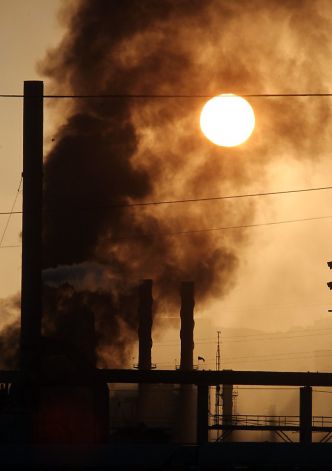Chevron firefighters may have gouged pipe
Jaxon Van Derbeken
Updated 10:45 pm, Thursday, January 3, 2013

A fire at the Chevron refinery in Richmond spewed a cloud of gas and smoke thousands of feet into the air on Aug. 6. Photo: Lance Iversen, The Chronicle / SF
A fire at Chevron's Richmond oil refinery in August appears to have been punctured from the outside, possibly by company firefighters trying to get at a small leak before the blaze ignited, investigators said Thursday.
The 40-year-old pipe had already been weakened by the heavy sulfur content of the crude oil being pumped through it, according to a draft metallurgical report on the fire that was prepared for federal and state investigators.
The pipe developed a small hole the afternoon of Aug. 6 that mushroomed into a larger leak and then a fire that destroyed part of the refinery and sent a cloud of gas and smoke thousands of feet into the air. No one was seriously hurt in the fire, but 15,000 people sought hospital treatment for respiratory and other problems because of the smoke.
The metallurgical report shows the expected evidence of corrosion that led to the pipe bursting, according to two officials of the U.S. Chemical Safety Board, the lead federal agency in the probe.
But separately, the investigation has also turned up something unexpected, they said: Photos of the inside of the line show that at the point where the pipe failed, it appears to have been punctured from the outside.
Firefighters' role?
Investigators are trying to determine whether Chevron firefighters responding to the first report of a small leak accidentally damaged the line as they tore away insulation.
"One theory we are exploring is that emergency response activities inadvertently accelerated the rate of the leak," said Daniel Horowitz, managing director of the Chemical Safety Board. "We are comparing possible tool marks on the pipe with tools recovered from the incident."
One tool that may have inflicted the apparent damage is a Halligan bar, which has a hook-like implement with a sharp end. Firefighters are commonly equipped with the device to help them gain entry into burning buildings.
Don Holmstrom, the Chemical Safety Board's lead investigator looking into the fire, said the blaze might well have happened even without the apparent puncture, but that the external damage could have been "an aggravating factor."
Investigators have not determined what sparked the blaze, but have raised questions about Chevron's decision to continue to run crude oil through the pipe even as workers responded to the initial, small leak.
"Regardless of the exact sequence of the events, this incident emphasizes the importance of effective decision-making in shutting down the unit promptly in case of a leak of this type," Horowitz said.
A Chevron spokesman issued a statement saying: "This is part of the ongoing investigation into the Aug. 6 fire at the refinery. We have been working closely and cooperatively with the investigating agencies, as well as conducting our own investigation. It is premature to comment on specific details until the investigations are complete."
A hydrocarbon vapor cloud spewed from the pipe soon after Chevron workers removed the insulation from the leaking line, federal investigators said. A resulting flash fire was quickly extinguished, but within minutes another blaze - fed by fumes escaping from a gash of several inches on the 8-inch-diameter pipe - ignited and consumed part of the refinery.
Corroded pipe
The draft metallurgical report, prepared by Anamet Inc. of Hayward, has been given to Chevron, investigating agencies and the union representing refinery workers. It might be released publicly after the parties' comments are included, investigators say.
The report affirms Chevron's theory that high-temperature, sulfur-laden crude caused the thinning and initial leak in the pipe, Holmstrom and Horowitz confirmed.
The pipe was made out of carbon steel, which Chevron has concluded was low in silicon and susceptible to corrosion from sulfur-heavy crude. In its effort to get the refinery fully back online, Chevron is installing pipe made out of a material called 9-Chrome, an alloy that contains more corrosion-fighting chromium.
Richmond officials had delayed issuing permits while two consultants evaluated whether Chevron's choice, 9-Chrome, was the best available technology. Chevron's own internal documents said stainless steel is more corrosion-resistant than 9-Chrome, but company officials told city officials that stainless steel is vulnerable to unpredictable cracking.
After Chevron threatened to lay off more than 600 workers if it didn't get city permits for the reconstruction, Richmond gave the go-ahead late last month - although Mayor Gayle McLaughlin said the affair left her frustrated.
"Had we had all the information first, that is always the better way to approach dilemmas and uncertainty," McLaughlin said. "Staff said they had an obligation to go forward - that it was an administrative decision and they made it."
Jaxon Van Derbeken is a San Francisco Chronicle staff writer. E-mail: jvanderbeken@sfchronicle.com
Read more: http://www.sfgate.com/bayarea/article/Chevron-firefighters-may-have-gouged-pipe-4166310.php#ixzz2H2Lj0yFC
|

